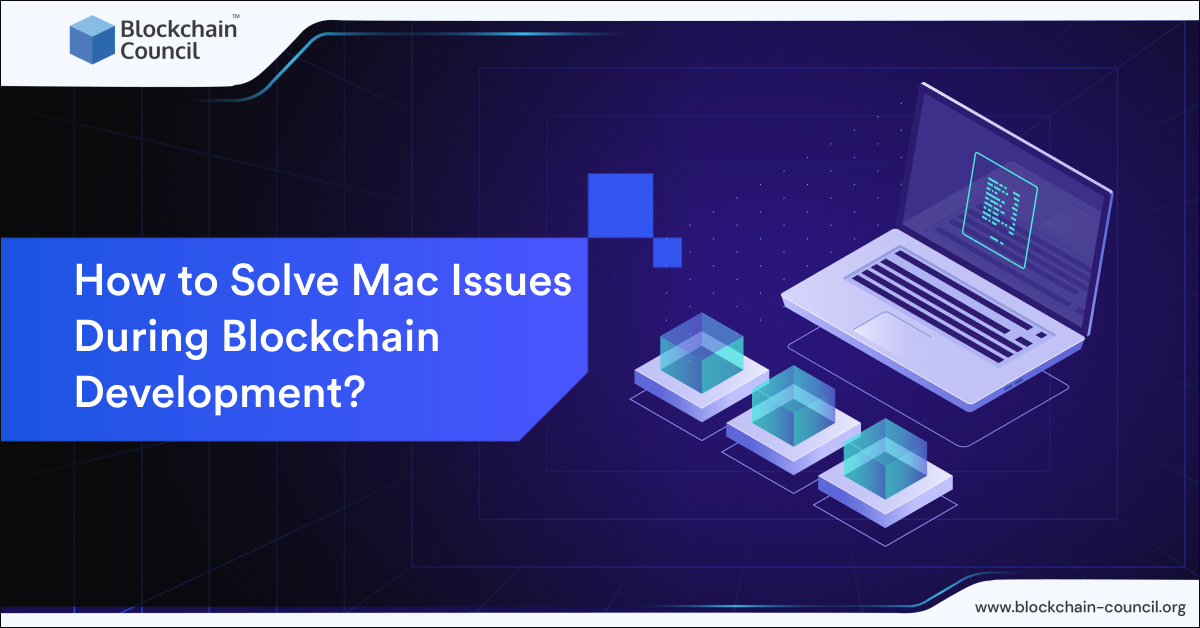
- Blockchain Council
- June 20, 2023
In recent years, the Blockchain concept has risen in popularity thanks to rapid technological advancement. Back in the day, it used to be a vague concept that most people hardly understood. However, the story is quite different today since everyone is talking about it, especially with the rise of cryptocurrencies such as Bitcoin. As cryptocurrencies boom, it’s quite fascinating that most revolutionary apps in the Blockchain field are still unnoticed. Blockchain development was responsible for the emergence of the cryptocurrency market. However, it hasn’t received the recognition that it deserves. The Blockchain field is not free of problems. There are several challenges that Blockchain developers face when using Mac. How can they overcome them? In this article, I am going to tackle this question.
Defining Blockchain
Most people associate Blockchain with Bitcoin. And automatically define Blockchain as cryptocurrency. However, these two aren’t the same thing. Blockchain is a system made up of a chain of blocks that store information in time order. It uses distributed ledger technology. This means that the chain is stored in each node that is linked to the Blockchain. In short, a Blockchain is made up of a network of nodes. Nodes are gadgets linked to the Blockchain through software. Before you start using your Mac for Blockchain development, you should ensure it is optimized for the job. One of the best ways to do this is to update AppStore apps and the operating system. If you don’t have time for this, scheduling automatic updates will ensure that your device operates smoothly regardless of the tasks you throw at it.
Common issues with Blockchain technology
Like everything in life, Blockchain systems have their cons. These cons make it difficult for people to adopt the technology on a massive scale. Here are some of the common issues that you’ll face during Blockchain development using your Mac:
1. Security
It’s quite difficult for hackers to forge transactions on the entire system. Altering a single transaction will require them to change relevant blocks stored in each node in the chain separately. While this technology might appear to be secure, you’ll only be secure as your weakest link. For instance, if a hacker wants to access information in an exclusive chain, they’ll only require one node to access it. The device that is easiest to access will always be a threat to the entire system. While it is almost impossible to forge transactions in the chain, a fraudulent transaction can get approved.
2. Transaction speed
One of the common problems that you’ll face with Blockchain technology is sluggish transaction speed. The decentralized nature of the system forces all transactions to be verified before they are accepted as blocks. Most centralized systems have a governing body that allows them to process a lot of transactions in a day
3. Energy consumption
Another common issue with Blockchain technology is the high consumption of energy. Redundancy, together with transaction validation, plays an important role in the high consumption of power. Apart from energy consumption, they require more storage compared to other systems. Every node processes and stores information just as much as the central body.
Become a Certified Blockchain Developer™
Effective solutions
1. Keep your network connection secure
Your network connection is the key component that enables your Mac to communicate with other gadgets and access the web. To use blockchain apps, you need a stable and secure network connection that receives and transmits huge amounts of information without interference or interruptions. Consider using a wired connection like Ethernet instead of wireless connections like Bluetooth or Wi-Fi for enhanced reliability and speed. Also install an antivirus, firewall, and VPN software to protect your device from hackers, censorship, and malware.
2. Use the right processor
The brain of your Mac is the CPU or processor. It is the component that determines how fast your gadget handles complex calculations and executes instructions. For blockchain apps, you require a processor that is capable of handling multiple threads, low power consumption, and high clock speeds. Depending on your preferences and budget, you should consider choosing Intel processors. Fortunately, most Macs usually have Intel processors which usually offer low power consumption and high performance.
3. Boost your memory
Your computer’s RAM is the short-term storage that allows your device to process and access information quickly. To develop a blockchain, you need more memory to handle huge amounts of information and prevent crashes. The amount of memory that you’ll require depends on the complexity and type of blockchain app that you are running. However, a minimum of 8GB RAM is what you need for optimal performance. Upgrading your memory will boost your gadget’s speed and efficiency.
4. Enhance the cooling system
The cooling system is the main component that regulates your computer’s temperature and prevents damage linked to overheating. As a blockchain developer, you need to optimize the cooling system of your Mac to dissipate the heat by the processor, GPU, and memory. The major types of cooling systems include liquid and air cooling. Liquid cooling uses pumps and tubes to circulate liquids around key components and cool them. On the other hand, air cooling uses fans to blow air over components to transfer heat. If you enjoy working in a quiet environment, liquid cooling will be ideal for you. However, it’s quite expensive to install.
Conclusion
These are some of the common issues that you’ll face as a blockchain developer while using your Mac. While they are big problems, solving them is quite easy. By using the solutions that we’ve discussed in this article, you’ll not only boost the speed of your device but also make it more durable.





































































 Guides
Guides News
News Blockchain
Blockchain Cryptocurrency
& Digital Assets
Cryptocurrency
& Digital Assets Web3
Web3 Metaverse & NFTs
Metaverse & NFTs
